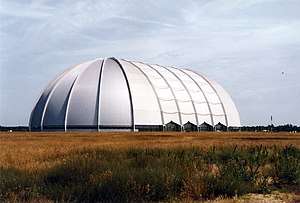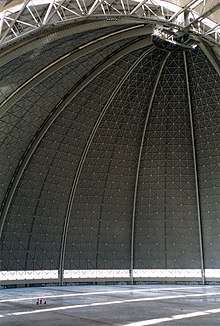CargoLifter
Cargolifter AG was a German company founded in 1996 to offer logistical services through point-to point transport of heavy and outsized loads. This service was based on the development of a heavy lift airship, the CL160, a 550,000 m3 (19,000,000 cu ft) vessel designed to carry a 160 t (160,000 kg; 350,000 lb) payload.[1] The airship was never built and the company went bankrupt in July 2002. Today the shareholder-founded CL CargoLifter GmbH & Co. KG company seeks to continue selling the lighter-than-air technology.


History
Company
Cargolifter AG was created on 1 September 1996 in Wiesbaden, Germany. A public stock offering took place in May 2000, and the resulting shareholder structure was characterized by a high proportion of small investors, attracted by substantial press coverage of the new breakthrough technologies being promised.
Hangar
The hangar for production and operation of the CL160 and engineering team facilities were built on the former Soviet Air Force base at Brand-Briesen Airfield, acquired to enable development and operations. The hangar (360 m or 1,180 ft long, 220 m or 720 ft wide and 106 m or 348 ft high), a technological marvel in itself, is a freestanding steel-dome "barrel-bowl" construction large enough to fit the Eiffel Tower on its side. The hangar was also equipped with a 180 m (590 ft) cutting table to manufacture the airship's envelope. After the company bankrupted, a tropical theme park was opened there.
Airship
The first CL 160 airship was never built, though a considerable amount of design and development work was undertaken. The technical complexity (something akin to designing an airliner with less vetted technology) along with limited funding (a fraction of the funding typically available for the development of new airliners), and short development timeline meant that program challenges were underestimated, making the project relatively risky.
A small manned prototype named 'Joey' was built in order to test project concepts on a reduced scale. Another aircraft, the "CL 75 Aircrane" transportation balloon prototype, of similar size (61 m in diameter) and height (87 m) to the CL 160, was built but destroyed in a storm in July 2002. Despite the setback, an agreement was reached with Boeing in 2002 for the joint study of a lighter-than-air stratospheric platform.[2]
The Cargolifter CL 75 AirCrane prototype, filled with 110,000 m3 of helium, was taken out of the hangar for the first time in October 2001. It represented a new stage in full-scale experimental purposes. The loadframe of this unit was engineered by American company AdvanTek International LLC, on behalf of Cargolifter AG. The sale of one CL 75 Aircrane along with 25 options (at a unit price of US$10 million), was later planned to the Canadian company Heavy Elevator Canada Inc., a deal with which CargoLifter AG was at least 20% involved. The contract never became effective.
Insolvency
On 7 June 2002 the company announced insolvency, and liquidation proceedings began the following month. The fate of parts of the 300 million euros in shareholder funds from over 70,000 investors is still unclear.
In June 2003, the company's facilities were sold off for less than 20% of the construction costs. The airship hangar was converted to a 'tropical paradise'-themed indoor holiday resort called Tropical Islands, which opened in 2004.
The Skyship airship, which had been purchased by Cargolifter for training and research purposes, was sold to Swiss Skycruise and used in Athens for flights connected with the Olympic games held there.
Continuation
Today, the CL CargoLifter GmbH & Co. KG company, founded by former Cargolifter AG shareholders, seeks to sell the lighter-than-air technology[3] and is exploring the construction of smaller airships.
See also
- Aeroscraft, a hybrid airship with the same aim as CargoLifter
- Walrus HULA
References
- "CL160". Retrieved 15 September 2006.
- "Cargolifter-Boeing agreement". Archived from the original on 26 August 2006. Retrieved 11 July 2006.
- "CL CargoLifter GmbH & Co. KG company's business objectives". Retrieved 12 July 2008.
External links
| Wikimedia Commons has media related to CargoLifter hangar. |